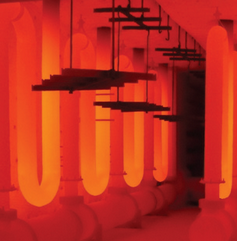Enamel technique - Essential terms
Porcelain Enamel
is a glass like material formed by melting with an inorganic
compound containing mainly oxides which is fused in one or more layers
onto metal or glass items at a temperature over 450°C.
(Videos in German Language)
Enamel-Frits
are the basic materials for enamelling. At temperatures of around 1,200
°C, a raw material mixture of quartz, feldspar, borax, soda, potash,
aluminium oxide, titanium dioxide and adhesion-forming metal oxides is
melted. This melting process takes place in rotating drum furnaces or
continuously in trough furnaces, almost exclusively in the specialized
plants of the enamel frit manufacturers. The enamel frit is produced by
the very rapid cooling and solidification of the glass melt in water or
between cooled rolls, which is called quenching. Depending on whether
the glass melt is quenched in water or dry between water-cooled rolls,
the enamel frit is a glass granulate or consists of glass flakes
Enamel-Slip
are produced as ready-to-order suspensions by wet milling of enamel frits and additives (e.g. quartz, clay, zirconium silicate), salt solutions and colors. Their rheological behaviour is adapted to the application process. Powders for electrostatic application or for application on hot castings are produced by dry grinding of the enamel frits.
Working with the Slip
The slip is applied in one or more layers to the pre-treated steel surface. After that the workpiece will be dried and transported to the kiln.
 Powder Enamel
Powder EnamelFrits are dry milled to powder and specially prepared so that they are suitable for powder electrostatic enamel application (PUESTA). A voltage of 60 to 90 kV is applied between the spray guns and the earthed workpiece. The enamel particles preferably move along the electrical field lines to the workpiece.

Burning
The burning temperatures and burning times can be adjusted according to steel thickness, workpiece and frits. usually between 825 - 850°C at 5 - 10 min.


